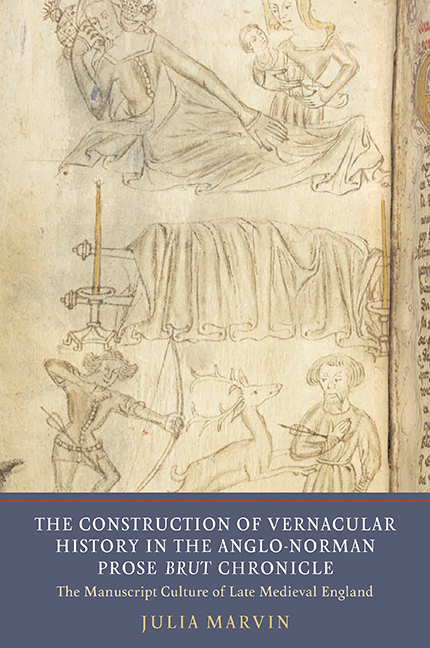 The Construction of Vernacular History in the Anglo-Norman Prose Brut Chronicle
The Construction of Vernacular History in the Anglo-Norman Prose Brut Chronicle Book contents
- Frontmatter
- Dedication
- Content
- List of Plates
- Acknowledgments
- Abbreviations
- A Note on Proper Names, Transcriptions, and Translations
- Introduction: Recognizing the Prose Brut Tradition
- Part I Construction
- 1 A New New Troy: Brut, Rome, and the Foundations of British History
- 2 The Community of the Realm: King, Baron, Brother, Stranger
- 3 Women with Voices
- 4 Social Arthur
- 5 The Continuity of the Realm
- Part II Reconstruction and Response
- Conclusion: Merlin's Power
- Bibliography
- General Index
- Index of Manuscripts Cited
4 - Social Arthur
from Part I - Construction
Published online by Cambridge University Press: 01 February 2018
- Frontmatter
- Dedication
- Content
- List of Plates
- Acknowledgments
- Abbreviations
- A Note on Proper Names, Transcriptions, and Translations
- Introduction: Recognizing the Prose Brut Tradition
- Part I Construction
- 1 A New New Troy: Brut, Rome, and the Foundations of British History
- 2 The Community of the Realm: King, Baron, Brother, Stranger
- 3 Women with Voices
- 4 Social Arthur
- 5 The Continuity of the Realm
- Part II Reconstruction and Response
- Conclusion: Merlin's Power
- Bibliography
- General Index
- Index of Manuscripts Cited
Summary
At times, King Arthur has seemed to scholars to be notably underrepresented in the literature of late-medieval England, particularly in light of the chivalric pageantry of the court of Edward III. Christopher Dean, for example, declared in 1987 that Arthur ‘is not the major character of medieval English fiction that manuals of Middle English literature with their inevitable chapter on Arthurian romance might suggest’. If this is so, it does not mean that Arthur was unpopular or unimportant in late-medieval written culture: it means that ‘fiction’ is not the best place to find him. The prose Brut chronicle made the literally prosaic Arthur more popular than ever before.
Arthur is the central figure of the Oldest Version of the Anglo-Norman prose Brut, and his reign constitutes its single longest episode. At 418 lines, it is about a tenth of the whole Oldest Version, or as much space as all the kings from Aethelred the Unready to Edward the Confessor, and it is twice as long as the life of Brut. In the later Anglo-Norman and Middle English Bruts, Arthur's story remains largely unchanged except for the eventual addition of prophecies of Merlin.
The audiences of the Oldest Version knew a very different Arthurian story from the one most familiar to audiences after Malory. Gunnore (Guinevere) appears in two sentences, to marry Arthur and to retire to a convent; there is no Grail quest, no Morgan le Fay, no Galahad, and no Lancelot. Here as elsewhere the Brut's account follows the Galfridian plot, conventionally labeled the ‘chronicle’, or English, tradition. The other branch of Arthurian literature, the so-called ‘romance’, or French, tradition epitomized in the poetry of Chrétien de Troyes, offers the erotic intrigues, tournaments, adventures in trackless forests, women in distress, and mystical quests associated with Arthur's court, as well as the adultery of Lancelot and Guinevere. Chrétien's romances and the later French prose Vulgate Cycle were both known in England, but aside from the account of Arthur's fall in the stanzaic Morte Arthur, relatively little of their plots entered the English language until Malory assimilated the matter of both traditions into his massive work.
- Type
- Chapter
- Information
- The Construction of Vernacular History in the Anglo-Norman Prose Brut ChronicleThe Manuscript Culture of Late Medieval England, pp. 93 - 112Publisher: Boydell & BrewerPrint publication year: 2017
